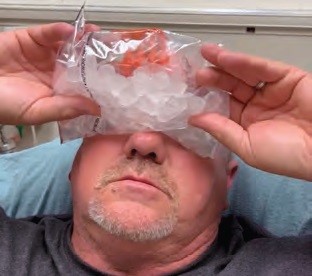
This patient is a 52-year-old male with past medical history of hypertension and hyperlipidemia who presented to the emergency department (ED) with approximately one month of progressive bilateral ptosis and one week of progressive bilateral diplopia and photophobia. The patient reported that these symptoms were more noticeable later in the day and worsened with reading and typing. The patient’s gaze disturbance was first noted by his wife, and he agreed to be evaluated by an optometrist. The patient was seen and instructed to report to the ED for concern of neuromuscular or intracranial pathology. After an unremarkable initial workup at an outside ED, which included head CT/CTA, blood chemistry, chest radiograph, and ECG, the patient was transferred to our tertiary care center for further neurological evaluation.

IMAGE 2: Upward gaze on presentation, note frontalis muscle compensation to lift eyelids.
The patient’s vital signs were within normal limits aside from mildly elevated blood pressure. Review of systems was positive for headache, diplopia, and photophobia. He denied recent fever, seizures, vertigo, limb weakness, stiffness, or pain. Reassuringly, the patient denied having any respiratory complaints. On physical exam, the patient exhibited bilateral ptosis (see Image 1). Extraocular range of motion was intact, but he had some difficulty with vertical gaze, which was easily fatigable and accompanied with noticeable compensation by the frontalis muscle (see Image 2). Further ocular testing revealed positive accommodation but marked photophobia. This prevented pupillary light reflex testing because the patient squeezed his eyelids shut to bright light. He was unable to complete visual field testing due to diplopia. The patient’s neck exhibited full active and passive range of motion with no tenderness or meningismus.

IMAGE 3: Administering the ice pack test.
The remainder of physical and neurological exams were unremarkable.
Diagnosis and Initial Treatment
The decision was then made to test for myasthenia gravis (MG) by application of an ice pack. A plastic bag was filled with ice, and the patient was instructed to hold this over his eyes for two minutes (Image 3). The ice pack was then removed, and both patient and examiners observed noticeable improvement. The patient’s ptosis was absent (Image 4). Extraocular range of motion was normal (Image 5), and the patient reported resolution of diplopia and photophobia. Pupillary light reflex was assessed and found to be normal. This effect lasted for approximately 90 seconds before ptosis reappeared. The test was conducted twice, approximately 15 minutes apart, with identical results, and the diagnosis of MG was made.
Pages: 1 2 3 4 | Single Page





No Responses to “Case Report: The Ice Pack Test”